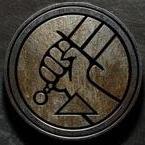Howard Mitchell
Posts: 449
Joined: 6/3/2002
From: Blighty
Status: offline

|
quote:
ORIGINAL: Hard Sarge
Yuck

Here’s an extract from a book about the Defiant and the Roc called ‘The Turret Fighters’ by Alec Brew, published by Crowood. The Roc saw almost no action, but here is one of the few examples of when it did:
“A well known engagement involved a 2 AACU (Anti-Aircraft Co-operation Unit) ROC, L3085, and Plt Off D. H. Clarke, who had painted a red ‘Saint’ (the Leslie Charteris character) in a red-framed yellow diamond on each side of the rear fuselage of his ‘own’ Roc. On 26 September 1940 he was sent out to search for survivors in the water 15 miles (24 km) south-west of St Catherines Point. With Sergeant Hunt in the gun turret – which, unusually for 2 AACU Rocs, was fully armed – he took off in the late afternoon. As he instituted a square search in the area indicated, he noticed what he thought was a Swordfish also searching about 3 miles (5 km) away.
After about 45 minutes of fruitless search in the gathering gloom, he suddenly noticed that the Swordfish, now only half a mile away, was in fact a twin engined floatplane. Out of curiosity, wondering what it was, he flew towards it: and then suddenly realised it was a Heinkel He 59, a German aircraft probably on the same air-sea rescue task as himself. Unsure as to whether he should open fire on an aircraft on such a humanitarian mission, he flew across its nose with Hunt training his turret at it.
As he did so the German nose gunner opened fire with his 7.9mm machine gun, and Hunt returned fire, his tracer pouring into the Heinkel’s fuselage. After the pandemonium and shock of his first action, Clarke swung on to a parallel course, and re-established communication with Hunt , whose intercom lead had been pulled out. The Heinkel turned for France, skimming the waves. Happily the twin engined bi-plane was even slower than the Roc, with a top speed at sea level of only 137 mph (220 kph), and Clarke was able to gain on his adversary; although he was still faced with the prospect of having to drop a wing to enable Hunt to open fire, even though his propeller was skimming the wave tops.
At 300 yards range he dropped a wing, and Hunt opened fire with another broadside. The Heinkel replied from all three gun positions, nose, dorsal and ventral, a single machine gun in each, but Clarke had to lift the wing after only a few seconds to avoid side-slipping into the sea, causing the last few rounds of Hunt’s burst to shoot harmlessly up into the air. The two aircraft continued these brief exchanges of fire for about 25 minutes, until the coast of France was looming up. Both aircraft were hit, and one of the Heinkel’s gunners stopped firing; but just as Clarke was about to turn away, the Roc was hit in the engine.
It faltered, and Clarke switched to the reserve 17 gal (77 ltr) tank, pulling up and away. Just as he thought he might have to ditch, the Perseus picked up, and he nursed the damaged aircraft back to Gosport. But before he could taxi in the engine stopped, out of fuel. Clarke claimed the Heinkel as ‘Damaged’.
On his return his groundcrew found two incendiary bullets in the main fuel tank, above which he sat. They had entered low down in the petrol, which had extinguished them; slightly higher, in the explosive fuel/air mixture above, and the Roc would have been ‘missing in action’. This action was almost certainly the nearest the Blackburn Roc ever came to destroying a German aircraft in combat”.
It is comforting to know that if the Germans had ever tried a massive low-level attack on Great Britain using twin engined float bi-planes, the Roc was there, ready and waiting to see them off. 
< Message edited by Howard Mitchell -- 4/28/2006 7:41:37 PM >
_____________________________
While the battles the British fight may differ in the widest possible ways, they invariably have two common characteristics – they are always fought uphill and always at the junction of two or more map sheets.
General Sir William Slim
|
 Printable Version
Printable Version


























 New Messages
New Messages No New Messages
No New Messages Hot Topic w/ New Messages
Hot Topic w/ New Messages Hot Topic w/o New Messages
Hot Topic w/o New Messages Locked w/ New Messages
Locked w/ New Messages Locked w/o New Messages
Locked w/o New Messages Post New Thread
Post New Thread